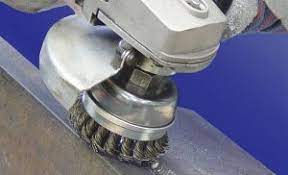SSPC-SP 3 Power Tool Cleaning
SSPC-SP 3 power tool cleaning is a standard the Society for Protective Coatings (SSPC) has established for surface preparation. Typically specified when surface preparation by sandblasting is not possible. SSPC-SP 3 is power tool cleaning, which is a method of surface preparation on steel surfaces with the use of power assisted hand tools.
2 Free CPD Hours Courses - Completely Free
Enroll, Watch the Video, Take the Test, Download Your Cert and Submit to the API . 2 free courses are availble each with 2 hours credit. (Total 4 hours) - 1) ASME V Articl II , 2) ASME V Article 6 & 7

The corrosion and deterioration caused by coating and lining failure are covered in multiple I4I Academy courses, such as the API 510 pressure vessel inspection course, API 570 piping inspection course, and API 653 Storage tank course. The I4I Academy API SIFE course also covers coating and lining inspection during the manufacturing process.
It is performed after SSPC-SP 1, solvent cleaning. Power tool cleaning is to remove loose rust, mill scale, and paint. The power tools used for this standard include sanders, wire brushes or wheels, chipping hammers, rotating flaps, needle guns, hammer assemblies, and right angle grinders. The use of such power tools allows for faster cleaning.
Through the use of impact or abrasion from these power tools, non-adhesive particles are removed in a faster and less expensive manner than some other cleaning methods. Although this method is convenient, it cannot be used to remove adherent forms of any rust, mill scale, and loose paint.
When is SPC-SP3 Power Tool Cleaning Used?
SSPC-SP3 power tool cleaning is frequently used when contamination to adjacent areas is a concern by sandblasting (SSPC-SP 5 & SSPC-SP 10) or is not feasible. Power tool cleaning has less particulate contamination than other forms of cleaning, such as abrasive blasting. When spot cleaning needs to be performed on the damaged coating and also on the surface-tolerant coating, such as oil-based paint SSPC-SP 3 power tool cleaning is recommended.
What Requirements Should be Met for SSPC-SP 3?
It is very important to note that SSPC-SP 1 must be performed prior to SSPC-SP 3 because oil, grease, and other visible salts need to be removed from the surface prior to power tool cleaning. Some coating specification requires a chloride test being performed before power tool cleaning even before solvent cleaning to identify the amount of deposited soluble salts.
Using good cleaning practices are essential to avoiding paint failure. Always blow off the surface with clean, dry, oil-free compressed air, brushing, or vacuum cleaning methods.
On welded work removal of all welding flux, slag, and fume deposit are necessary as those are the contents that promote paint failure on welding joints.
What standards should be considered for SSPC-SP 3 Power Tool Cleaning?
Based upon the coating specification set for each project, consensus reference photographs (SSPC-VIS 3) can be required in conjunction with SSPC standards. Consensus reference photographs are photographic aids that can assist in establishing the general appearance of the surface after SSPC-SP 3 power tool cleaning is performed. These consensus reference photographs are supplementary and can be used in conjunction with SSPC surface preparation standards to better accomplish the process of SSPC-SP 3 power tool cleaning.
Note that as supplements, every project will have its conditions that need to be met. Therefore, it is best not to apply the same consensus reference photographs and the SSPC surface preparation standards for all projects because they will all vary based on the steel conditions and cleaning operations.
Although consensus reference photographs are currently not a code or standard requirement but, it is highly recommended that procurement documents require these aids to establish uniformity in approaching SSPC standards. Besides, another benefit to using such aids is that it makes it easier to distinguish the difference between the various grades. It is highly important to note, although these aids are valuable, the written standards are always primary and hold the highest level of authority to meeting cleaning standard requirements.
What is SaSPC-VIS 3?
Consensus reference photographs for the SSPC-SP 3 power tool cleaning are introduced as SSPC-VIS 3. Depending on the procurement documents, either SSPC-VIS 3 or other various visual standards are required to be followed in conjunction with the surface preparation standards.
SSPC-VIS 3 provides photograph references for several grades of cleaning, one of which includes SSPC-SP 3 power tool cleaning. It provides photograph references for seven conditions of the surface, four unpainted and three painted surfaces.
Always note that using these references should never be a substitute to following the SSPC-SP 3 power tool cleaning standards.
Although photographic references can be part of the coating specification document, it can be difficult to compare surfaces with photographs. So it is in the best interest of the owner to provide the contractor with sample surfaces of what is expected.
How much Power Tool Cleaning is too much?
The degree of power tool cleaning required of SSPC-SP 3 is based on the condition of the surface and also the new painting system. The SSPC documents identify four conditions defined as conditions E, F, G, and H provide information on the previously painted surfaces that will undergo power tool cleaning for maintenance. Therefore, the degree of power tool cleaning can also be identified through the conditions system provided in the SSPC visual consensus references.
Also, avoid excessively roughening or slicking the surface as that may also lead to premature paint failure.